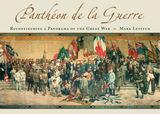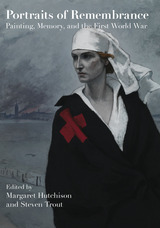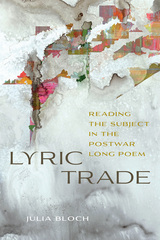2 books by Levitch, Mark

Mark Levitch
University of Missouri Press
In its day it was, quite simply, the world’s largest painting.
The Panthéon de la Guerre was a cyclorama the size of a football field, featuring 5,000 full-length portraits of prominent figures from World War I—a painting that blatantly sought to arouse patriotic fervor in its viewers. This book traces that work’s shifting fortunes during its unlikely journey from Great War Paris to cold war Kansas City and examines the continuing journeys of its fragments in the world’s art markets.
Mark Levitch has written the first history and analysis of the Panthéon, capturing its social life in a story full of surprising twists and turns and as epic as the painting itself. Created in Paris as an artist-generated propaganda project while the war raged, the Panthéonwas celebrated there as a solemn and nostalgic work after the war, then was promoted as a circuslike spectacle on a postwar tour of the United States when it was “updated” to appeal to Americans’ more celebratory view of the conflict. Consigned to storage and all but forgotten after World War II, the Panthéon was eventually procured for Kansas City’s Liberty Memorial in 1956, where less than 7 percent of the work was reconfigured into a smaller U.S.-centric mural—some of the unused fragments eventually surfacing in Paris flea markets and on eBay.
Levitch looks at the Panthéon as both painting and artifact, combining cultural history, art history, and material culture studies to trace the changing reception of traditional art in the new age of mechanical media. He assesses the changing values attached to the Panthéon and argues that the panorama’s status and frequent reshaping have both informed and been informed by the experience and memory of the First World War in France and the United States—and also reflects on how it has promoted a politically and culturally conservative agenda.
Brimming with facts and insights that will amaze anyone who has known the painting in any of its incarnations, Levitch’s handsomely illustrated book provides a unique lens through which to view a conflict and its commemoration. And as people continue to place importance on commemorative projects, it is a powerful reminder of how ephemeral such grand undertakings can be.
[more]

Portraits of Remembrance
Painting, Memory, and the First World War
Edited by Margaret Hutchison and Steven Trout
University of Alabama Press, 2020
Interdisciplinary collection of essays on fine art painting as it relates to the First World War and commemoration of the conflict
Although photography and moving pictures achieved ubiquity during the First World War as technological means of recording history, the far more traditional medium of painting played a vital role in the visual culture of combatant nations. The public’s appetite for the kind of up-close frontline action that snapshots and film footage could not yet provide resulted in a robust market for drawn or painted battle scenes.
Painting also figured significantly in the formation of collective war memory after the armistice. Paintings became sites of memory in two ways: first, many governments and communities invested in freestanding panoramas or cycloramas that depicted the war or featured murals as components of even larger commemorative projects, and second, certain paintings, whether created by official artists or simply by those moved to do so, emerged over time as visual touchstones in the public’s understanding of the war.
Portraits of Remembrance: Painting, Memory, and the First World War examines the relationship between war painting and collective memory in Australia, Austria, Belgium, Canada, Croatia, France, Germany, Great Britain, New Zealand, Russia, Serbia, Turkey, and the United States. The paintings discussed vary tremendously, ranging from public murals and panoramas to works on a far more intimate scale, including modernist masterpieces and crowd-pleasing expressions of sentimentality or spiritualism. Contributors raise a host of topics in connection with the volume’s overarching focus on memory, including national identity, constructions of gender, historical accuracy, issues of aesthetic taste, and connections between painting and literature, as well as other cultural forms.
Although photography and moving pictures achieved ubiquity during the First World War as technological means of recording history, the far more traditional medium of painting played a vital role in the visual culture of combatant nations. The public’s appetite for the kind of up-close frontline action that snapshots and film footage could not yet provide resulted in a robust market for drawn or painted battle scenes.
Painting also figured significantly in the formation of collective war memory after the armistice. Paintings became sites of memory in two ways: first, many governments and communities invested in freestanding panoramas or cycloramas that depicted the war or featured murals as components of even larger commemorative projects, and second, certain paintings, whether created by official artists or simply by those moved to do so, emerged over time as visual touchstones in the public’s understanding of the war.
Portraits of Remembrance: Painting, Memory, and the First World War examines the relationship between war painting and collective memory in Australia, Austria, Belgium, Canada, Croatia, France, Germany, Great Britain, New Zealand, Russia, Serbia, Turkey, and the United States. The paintings discussed vary tremendously, ranging from public murals and panoramas to works on a far more intimate scale, including modernist masterpieces and crowd-pleasing expressions of sentimentality or spiritualism. Contributors raise a host of topics in connection with the volume’s overarching focus on memory, including national identity, constructions of gender, historical accuracy, issues of aesthetic taste, and connections between painting and literature, as well as other cultural forms.
[more]
READERS
Browse our collection.
PUBLISHERS
See BiblioVault's publisher services.
STUDENT SERVICES
Files for college accessibility offices.
UChicago Accessibility Resources
home | accessibility | search | about | contact us
BiblioVault ® 2001 - 2024
The University of Chicago Press









